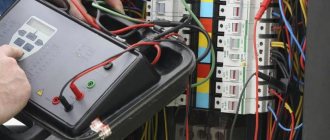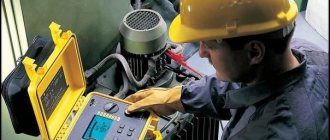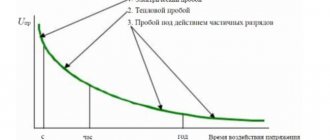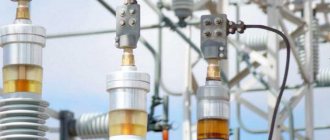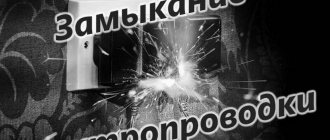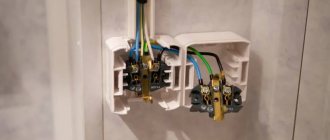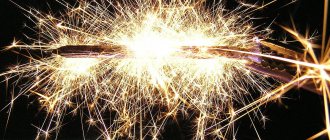Causes of electrical fires
A short circuit fire is caused by a number of factors. Let's look at some of them in more detail.
Violation of insulation and contact
Damage occurs as a result of oxidation of contact surfaces, caused by overheating. An increase in metal temperature causes it to expand and touch the cables. As a result, contact of two polarities occurs, causing a short circuit.
Errors in connection and cross-section of wires
The cause of a short circuit in the apartment may be cable contacts. The interaction of copper and aluminum wires causes diffusion. As a result, gradual heating to high temperatures occurs.
Wire size is also important. Any cable is designed for a certain load
Exceeding the permissible values at the joints causes heating, which can cause further ignition. Below is a table of correspondence between cable core thickness and maximum load.
Incorrect gasket
Cables located in the house, electrical room or on the roof of the room must be correctly connected and laid. Relevant for hidden wiring, where it is impossible to notice the moment of fire.
When installing a cable into a wall, you need to minimize sharp edges, as they can damage it during installation.
Questionable and faulty electrical appliances
The devices used must be of proper quality and have additional safety measures. For example, some kettle manufacturers increase the insulation of the wires, which reduces the risk of a short circuit.
Malfunction of protection devices
To minimize short circuits, a machine is installed at the entrance to the apartment. It will automatically turn off the power during a power surge, which will prevent a fire.
Damage to plugs and sockets
When electrical appliances are connected to the network, contacts interact, which become loose over time, leading to excessive heating. Such problems are characterized by crackling and sparking. The plug overheats, the socket melts, the contacts stick to each other, and a fire occurs.
Damaged socket
Procedure for detecting the first signs of fire
If, when connecting one or more devices to the network, you hear the smell of burning plastic, you need to immediately take certain measures, because This is a clear sign of an electrical fire.
You need to proceed as follows:
- All repair work is carried out in a de-energized room, so first you need to unscrew the plugs.
- In a room where the smell of burning wiring was heard, it is necessary to disassemble all sockets and check the wires and contacts. Most often, the contact under the pressure washer weakens, which leads to overheating.
- If all sockets are in good condition, you should look into the junction box. It will not be difficult to notice the damaged area: the contact will be blackened, the cable insulation will have melted.
- In the case of faulty sockets, the wires are stripped and the contacts are restored. If a fire occurs in a junction box, then it is better to cut out the damaged area and insert another cable of the same cross-section in its place. The connection must not be made by twisting; the wires must be soldered, then the exposed areas must be insulated.
- If it turns out that the wiring has burned out over a significant length, you will have to completely replace the entire cable.
The fire safety of electrical wiring with aluminum conductors is lower than that of copper wiring. This is explained by the fact that aluminum tends to oxidize in air, which causes resistance at the junction of the wires to increase, which leads to overheating and fire. Therefore, it is better to completely replace such electrical wiring.
This process is quite painstaking and requires certain knowledge and skills. If you are not confident in your own abilities, it is better to seek the help of a professional electrician.
Correct actions in case of fire
First of all, it is necessary to take all measures to turn off the power to burning electrical appliances. You can do this in several ways:
- Unplug the device from the socket. This is only permitted if the flame does not damage the insulation on the plug, socket, or nearby sections of the wire.
- Turn off the circuit breaker that feeds the line (or the switch that supplies electricity to the room where the fire occurred).
- Use an ax to cut the cable or wire that supplies electricity to the burning appliance.
Please note that the device may be connected to a UPS or backup power source. Then it will remain energized even after the main line is turned off.
If for some reason it is impossible to de-energize the line on which the fire occurred, they begin to extinguish the fire with means that do not conduct current. If necessary, evacuation and notification of the fire service are also carried out.
Actions in case of electrical fire
Electricity is an integral part of every person’s life, which makes life easier and more comfortable. However, if certain rules for using electricity are not followed or working with faulty electrical appliances can lead to property damage or pose a threat to human life and health. For example, many people live in houses that were built several decades ago, and the electrical wiring of the premises remains from those times. Of course, the condition of such electrical wiring leaves much to be desired, and if the wires are not replaced in time, a fire may occur, which in the worst case may develop into a fire.
How can you extinguish live wiring?
It happens that when an electrical wiring catches fire, there is no person nearby and it is impossible to quickly put out the flames. In these cases, in order to prevent a fire, it is necessary to act quickly and it is not always possible to run to the electrical panel to turn off the power to the house. A fire in its initial stages can be extinguished using earth and sand. But for such emergencies, it is better to have a special fire extinguisher in the house. Not all types of this device can be used to extinguish live appliances and electrical wiring. Therefore, before purchasing, you need to figure out which fire extinguisher can extinguish electrical wiring.
The best option is a carbon dioxide fire extinguisher, which can be used to extinguish fires in electrical installations under voltage up to 10,000 V. The extinguishing agent has a low temperature and is supplied under high pressure. Due to this, it is possible not only to eliminate the fire, but also to cool the smoldering sections of the electrical wiring. The main disadvantage of this device is that the vapors released during evaporation are harmful to human health. Therefore, it is prohibited to use a carbon dioxide fire extinguisher to extinguish fires in unventilated areas.
For apartments and private houses where the network voltage does not exceed 380 V, a good option would be to purchase a powder fire extinguisher, which can be used to extinguish electrical installations under voltage up to 1000 V. The powder agent quickly eliminates the fire by isolating the source of the flame from oxygen.
If it is possible to turn off the power, you can use water and foam fire extinguishers. Otherwise, you cannot extinguish electrical wiring with such means, because a person can be electrocuted. When extinguishing a fire, a distance of 1 meter must be maintained.
Prevention measures
If the electrical installation rules were followed when installing electrical wiring, then proper handling of electrical appliances minimizes the risk of wire fires. However, you cannot be 100% sure on this issue, and to prevent possible problems it is better to follow the recommendations described below.
You cannot use many tees and extension cords; it is advisable to lay the cord from them along the walls so that people do not step on it or heavy objects are placed on it. You need to know that the maximum current for a single-phase socket is 16 A. If this threshold is exceeded, the current protection may not work and the socket will become dangerous.
It is necessary to inspect junction boxes several times a year. The contacts are checked for the strength of the connection, and the oxidation layer, if one has formed, is cleaned.
It is necessary to monitor the condition of the sockets and periodically check the reliability of the clamping contacts. Worn-out products may begin to spark, which can subsequently cause a fire and develop into a fire.
Heating electrical appliances that are turned on must be constantly monitored. If you need to leave the house for a long time, you can turn off the electricity supply at the electrical panel.
How to extinguish electrical appliances and wiring?
There are several safe ways to extinguish burning wiring or electrical devices:
- Filling the fire with sand. The main thing is that the material is not wet.
- Use of powder fire extinguishers. This product is safe for extinguishing devices powered by voltages up to 1 kV.
- Carbon dioxide fire extinguishers of the OU series extinguish fires in installations powered by voltages from 1 to 10 kV.
Extinguishing fires with carbon dioxide poses additional hazards. First of all, carbon dioxide creates a large amount of non-flammable gases (carbon dioxide, carbon monoxide). These products are poisonous to humans and are deadly in large concentrations. Therefore, only fires located in large rooms can be extinguished with such a fire extinguisher.
To minimize the risk of electric shock, you need to stand so that there is at least 3 m of space between the fire extinguisher nozzle and the fireplace. When extinguishing a device powered by a voltage of up to 1 kV, the safe distance is 1 m.
In addition, when released, carbon dioxide instantly cools. Therefore, if the jet comes into contact with the skin, there is a risk of frostbite. Holding the fire extinguisher nozzle with your bare hand is also unsafe.
Extinguishing electrical wiring, power lines, electrical appliances and installations with water, foam and water-foam compositions is strictly prohibited!
Fighting fires is a process that requires highly trained skills and a calm head. To be sure of the safety of your home, purchase a safe fire extinguisher (class “E”) in advance and teach all family members how to use it.
Source
Overloads as an emergency mode of operation of electrical equipment
Overload
This is called
an emergency mode
in which currents arise in the conductors of electrical networks, machines and devices that for a long time exceed the values allowed by the standards.
One of the types of transformation of electrical energy is its conversion into heat. Electric current in the conductors of electrical networks, machines and devices releases heat, which is dissipated in the surrounding space. Conductors can reach dangerous temperatures. Thus, for bare copper, aluminum and steel wires of overhead lines, the maximum permissible temperature should not exceed 70°C. This is explained by the fact that with increasing temperature, oxidative processes intensify and oxides with high resistance are formed on the wires (especially in contact connections); The contact resistance increases, and, consequently, the heat generated in it. As the connection temperature increases, oxidation increases, and this can lead to complete destruction of the wire contact.
The cause of
overload may be caused by incorrect calculation of conductors during design. If the cross-section of the conductors is underestimated, then when all the provided electrical receivers are turned on, an overload occurs. Overload may occur due to the additional inclusion of electrical receivers for which the network conductors are not designed.
To avoid overload or its consequences, during design it is necessary to correctly select the cross-sections of network conductors according to the permissible current, as well as electric motors and control devices.
During the operation of electrical networks, you cannot turn on additional electrical receivers if the network is not designed for this.
Some features of stewing
In the event of an electrical equipment fire, an indispensable condition is to influence the source of the fire from top to bottom. The fire extinguisher must not be brought within 1 m of an electrical installation engulfed in flames. It is most effective to influence a fire using several devices simultaneously.
To avoid frostbite on hands not protected by special gloves, it is not recommended to handle the nozzle of a carbon dioxide fire extinguisher, which is aimed at the flame.
It is necessary to start extinguishing from the leeward side, directing the stream of substance to the edge of the fire.
In case of fire in electrical installations under voltage, aerosol fire extinguishers must be used.
In the event of a fire in technological rooms for the placement of electrical equipment - server rooms, equipment rooms, switchboards, you need to use halon fire extinguishers.
Extinguishing electrical wiring
If electrical contact occurs between points of an electrical circuit with different potentials (short circuit), a fire may start.
Attention! Do not extinguish live electrical wiring with water! This is strictly prohibited as it may result in electric shock.
When a flame appears, the first thing you need to do is immediately turn off the electricity on the panel. If the network is de-energized, then you can use any available fire extinguishing means at hand - water, sand or a fire extinguisher. To eliminate fires in electrical installations, powder and aerosol extinguishing agents are used (see above). If an open fire appears, you must turn off the electricity at the panel. If this is not possible, immediately call the fire brigade.
Extinguishing household electrical appliances
According to the set of rules SP 9.13130.2009, it is necessary to use fire extinguishing agents when household electrical appliances catch fire.
- Fire extinguishers with powder filling are allowed to extinguish electrical equipment up to 1000 Volts.
- Carbon dioxide fire extinguishers are allowed to extinguish electrical installations under voltage up to 10,000 Volts (10 kV).
- It is strictly prohibited to use carbon dioxide agents to extinguish electrical equipment with voltages higher than 1 kV when the length of the fire extinguishing agent jet is less than 3 meters.
Elimination of short circuit consequences
If the search for the short circuit was successful, then it’s time to exhale and start eliminating it. What to do next depends on the extent of the damage to the electrical wiring. Regardless of the situation, before starting any repair work, you should definitely turn off the power to the apartment and make sure there is no voltage.
It is necessary to assess how much the cable insulation was damaged at the time of the short circuit. If there are swelling, darkening or melting, the wire must be replaced. If possible, it is necessary to assess its condition along its entire length.
Connecting wires in the distribution box using terminal blocks
If the wire covering is in order, then the immediate location of the short circuit is removed. The surviving ends of the current-carrying conductors are stripped and connected using Wago terminal blocks, welding, soldering or crimping. In low-current circuits, you can use regular fast twisting at your own risk. However, the PUE (7th edition, clause 2.1.21) does not provide for and does not approve of this method of connecting cables.
What is a short circuit: definition, explanation for dummies
We often hear “There is a short circuit”, “There is a short in the circuit”. It is immediately clear that something unplanned and bad happened. But why is the circuit short and not long? Let's put an end to the uncertainty and figure out what exactly happens when there is a short circuit in the electrical circuit.
What is a short circuit (SC)
An electric stingray swims in the ocean and does not create a short circuit, completely dispensing with knowledge of Ohm's law. For us, to understand the nature and causes of a short circuit, this law is simply necessary. So, if you haven’t already, let’s read about Ohm’s law, current, voltage, resistance and other wonderful physical concepts.
Now that you know all this, you can give the definition of a short circuit from physics and electrical engineering:
A short circuit leads to the formation of destructive currents that exceed permissible values, failure of devices and damage to wiring. Why is this happening? Let us examine in detail what happens in the circuit during a short circuit.
Let's take the simplest chain. It contains a current source, resistance and wires. Moreover, the resistance of the wires can be neglected. Such a diagram is quite sufficient to understand the essence of the short circuit.
The simplest electrical circuit
In a closed circuit, Ohm's law applies: current is directly proportional to voltage and inversely proportional to resistance. In other words, the lower the resistance, the greater the current.
More precisely, for our circuit Ohm’s law will be written in the following form:
Here r is the internal resistance of the current source, and the Greek letter epsilon denotes the emf of the source.
By the way! For our readers there is now a 10% discount on any type of work
Types of short circuits and their causes
In everyday life, short circuits occur:
- single-phase - when the phase wire is shorted to zero. Such short circuits happen most often;
- two-phase - when one phase is closed to another;
- three-phase - when three phases are closed at once. This is the most problematic type of short circuit.
For example, on Sunday morning, your neighbor behind the wall connects phase and neutral in the socket by plugging in a hammer drill. This means that the circuit is closed and the current flows through the load, that is, through the device plugged into the outlet.
If a neighbor connects the phase and neutral wires in the socket without connecting the load, then a short circuit will occur in the circuit, but you will be able to sleep longer.
note
For those who do not know, for a better understanding it will be useful to read what phase and zero are in electricity.
A short circuit is called a short circuit, since the current in such a circuit closure seems to follow a short path, bypassing the load. A controlled or long circuit is the usual, familiar to everyone, plugging in devices into a socket.
Short circuit protection
First, about what consequences a short circuit can cause:
- Damage to a person by electric shock and generated heat.
- Fire.
- Failure of devices.
- Power outage and lack of internet at home. As a result, there is a forced need to read books and dine by candlelight.
Short circuit - possible cause of fire
As you can see, a short circuit is an enemy and a pest that needs to be fought. What are the methods of short circuit protection?
Almost all of them are based on quickly opening the circuit when a fault is detected. This can be done using various short circuit protection devices.
Almost all modern electrical appliances have fuses. High current simply melts the fuse and the circuit breaks.
The apartments use short circuit protection circuit breakers. These are circuit breakers designed for a specific operating current. When the current increases, the machine is triggered, breaking the circuit.
To protect industrial electric motors from short circuits, special relays are used.
Short circuit protection circuit breaker
Now you can easily define a short circuit, at the same time you know about Ohm’s law, as well as phase and zero in electricity. We wish everyone not to cause short circuits! And if you are stuck in your head and have absolutely no energy for any work, our student service will always help you cope with it.
And finally, a video about how NOT to handle electric current.
The Hidden Threat: How to Avoid Electrical Short Circuits
Short circuit of electrical wires is one of the most common causes of fires.
Why the electrical wiring shorts out and how to avoid it, the CoES of the Ministry of Internal Affairs of the Republic of Kazakhstan told, Zakon.kz reports.
Warning signs
As the department's press service reported, there are several reasons for the short circuit. This is low quality insulation, improper installation of electrical wiring, poor contact in the connections of wiring and electrical appliances.
Another reason is overheating and destruction of insulation due to the use of electrical appliances that consume high current and the wiring is in poor condition.
To avoid overload, it is necessary to connect such a number of electrical appliances that their total power does not exceed the rated power of each power line.
Also, to ensure fire safety, automatic fuses should be installed in the distribution panels at the electrical input to the apartment or house, which can turn off the network in the event of an overload.
However, it happens that the fuse turns off several times in a row. In such a situation, it is necessary to turn off energy-intensive devices that are causing network overload, wait a few minutes and turn on the fuse.
Advice
If the fuse continues to turn off, this is an alarming signal: it is urgent to check the electrical wiring, electrical equipment, and detect possible problems in the network and electrical appliances.
In the event of a short circuit, the process of disconnecting the fuse occurs very quickly, and therefore is called “cut-off”. If the fuse is switched on to the damaged network, it will switch off again.
Safety regulations
Do not use old wires with inadequate insulation.
Be careful when carrying out electrical installation work. Do not drill, tap, or cut walls in places where the power cable is laid.
Remove the insulation during installation very carefully, do not cut the wire with a knife along the cores.
Make sure that the network is turned off when working with it. It is necessary to post a notice on the sign with the following content: “Work in progress, do not turn on the electricity” or appoint a duty officer who will report this verbally.
Install protective shutdown devices - circuit breakers.
Do not operate damaged electrical appliances.
When installing wiring, do not run the wires in one large bundle; it is better to run them parallel next to each other or use special boxes.
Following these simple rules will significantly reduce the risk of a short circuit. However, in the event of a fire, the most important thing is not to panic!
It is easier to avoid danger if you act calmly and wisely.
If you understand that you cannot cope with the fire yourself, immediately report the fire from your mobile or landline phone to the unified rescue service number “101” or “112”.
More important news in the Telegram channel “zakon.kz”. Subscribe!
Report a bug
4917849-7f45c7b5bb1505aaab2ea51b9f5729e8
Basic common sense: why can’t you extinguish electrical appliances with water?
Firefighters and electricians unanimously say: extinguishing electrical appliances with water is strictly prohibited! This is due to water's ability to conduct electricity, which creates a risk of electric shock. There are other ways to extinguish burning wiring and electrical appliances. Let's figure out how to properly act in case of fires caused by a short circuit.
Transition resistances
Transitional
are called
resistances
in places where current passes from one contact surface to another through the areas of their actual contact
.
In such a contact connection, a certain amount of heat is released per unit time, proportional to the square of the current and the resistance of the areas of actual contact.
The amount of heat generated can be so significant that the transition resistances become very hot. Consequently, if heated contacts come into contact with flammable materials, they may ignite, and contact of these places with explosive concentrations of flammable dust, gases and vapors of flammable liquids will cause an explosion.
To increase the areas of actual contact between the contacts, it is necessary to increase their compression forces by using elastic contacts or special steel springs.
To remove heat from points of contact and dissipate it into the environment, contacts with sufficient mass and cooling surface are required.
Thus, to ensure safe working conditions in existing electrical installations
a set of measures should be provided that are implemented at all stages - before the start, during the implementation and at the completion of the work. Activities mean the organization of certain actions in electrical installations (registration of work, appointment of those responsible, preparation of the work site, conducting briefings, etc.), as well as specific manipulations with electrical installation devices (switching, checking the presence or absence of extinguishing in live parts, installation of protective grounding and others). In addition, it is worth taking into account local conditions and applications of electrical installations.
Considered causes of fires
are relevant.
Today, a person cannot do without machines, installations and computers. Every year, as practice shows, the use of electrical installations is increasing, and the sooner measures to prevent fires are developed and taken, the safer the future awaits us. No tags for this post.
Which fire extinguisher should you use to extinguish electrical equipment?
In the event of a fire, the following types of fire extinguishers are used:
Powder fire extinguishers
The main indicator of the performance of a powder fire extinguisher is the correct spraying of the extinguishing agent under pressure. The mixture contains ammonium salt, sodium and potassium salt with specialized additives. As a rule, this type of fire extinguisher is used to stop any fires. When sprayed, the powder mixture covers and envelops the surface of the object. The air supply stops and the fire goes out. The use of powder fire extinguishers is permitted for class fires (A – D, see table above).
In practice, this method of extinguishing a fire is not very popular. When extinguishing valuable objects, rooms in which documentation is stored, instruments, electronics, this method is not recommended, since it is almost impossible to thoroughly clean the equipment.
Air foam fire extinguishers
Air-type fire extinguishers are filled with a composition consisting of water and foaming additives.
When the trigger mechanism is activated, carbon dioxide squeezes out the foam solution under high pressure conditions. Next, the foaming agent in a special nozzle is mixed with air, forming foam, which cools the flammable items. When extinguishing, a foam film is formed, isolating the surface with open fire from oxygen.
Air-foam fire extinguishers are used when burning solids, flammable and flammable liquids (fire class A and B, see table above).
Carbon dioxide fire extinguishers
These devices for extinguishing fires are cylinders filled with liquefied carbon dioxide (CO2). These devices are used for extinguishing in cases where, during a fire, a flammable substance interacts with an oxidizer. The role of the oxidizing agent here is played by the oxygen contained in the air. The use of carbon dioxide fire extinguishers is permitted for class B, C and E fires (electrical installations under voltage up to 10 kV). For substances that can smolder or burn without the participation of an air mixture, the use of carbon dioxide is ineffective.
Aerosol fire extinguishers (GOA and AGS)
Extinguishing in aerosol fire extinguishers occurs either with the help of a solid filler, where the fire extinguishing aerosol is released under the influence of a flame, or with the help of a finely dispersed powder composition. The use of GOA and AGS is very productive in case of fire in electrical installations under voltage.
Freon fire extinguishers (marked OX)
Devices of this type are charged with a mixture of hydrocarbon derivatives, including fluorine, chlorine, and bromine substances. This is a relatively new method of extinguishing, and very effective. A serious disadvantage is that a person can stay in a room where this fluorine-containing gas is sprayed for no more than five minutes due to its toxicity. Halon fire extinguishers are successfully used in cases of fire of electrical equipment, in server rooms, equipment rooms, control rooms, electrical switchboards, and generator rooms.
